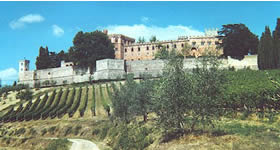Il Chiantigiano

The Chiantigiano is the territory where the Chianti Classico wine has been produced for centuries. It is a geographical area in Tuscany, which borders with the Florence hinterland to the north, with the Chianti Mountains to the east, with Siena to the south and with the Val di Pesa and the Valdelsa to the west. It includes the municipalities of Castellina in Chianti, Gaiole in Chianti, Greve in Chianti and Radda in Chianti and part of the municipalities of Barberino Val d' Elsa, Castelnuovo Berardenga, Poggibonsi, St. Casciano in Val di Pesa and Tavarnelle Val di Pesa.
One characteristic of this hilly area between 250 and 800 m asl is its continental climate with remarkable thermic excursions throughout the seasons and even during the day.
Together with not excessive, mean precipitations mainly concentrating in spring and autumn, this climate makes Chianti a geographical area scarcely suitable for specific farming but it is the ideal place for producing high-quality wine and oil.
This is why many people call this area the "Garden of Europe", since it is rich in bucolic atmospheres and framed by mildly sloping hills. It is not a case if some years ago the Chianti entered was a candidate to enter among the territories preserved by UNESCO as "World Heritage".
The origin of the name "Chianti" is still uncertain. According to some, it was born from the Latin term "clangor", meaning "noise", to celebrate the bustle of battues.
In effect, the woods of this area were places where the hunting activity had been proliferating since ancient times. According to the pro-Etruscan interpretation, the name derived from the word "clante". Beyond being a name largely used in the ancient Etruscan families, it was a word also designating the abundant water of the area.
This diatribe confirms the Etruscan-Roman origin of the first settlements. In the Middle Ages, the area became the usual battlefield in the fight between Florence and Siena and it was during this period that villages, castles and strongholds developed to constitute the historical nucleus of towns and aristocratic residences.
Chestnut groves and oak-woods were more and more substituted by vineyards and olive plantations that soon became the backbone of the local economy. The first notarial document where the name Chianti refers to the locally produced wine dates to 1398.
In the XVII century, the Chiantigiano already exported its wine on a regular basis. The following century brought new social changes on this area.
On September 24, 1716, the Grand Duke Cosimo I de' Medici made an announcement, which was the predecessor of the existing "Checked Origin Name", that specified the borders inside which some kinds of wine could be produced; among them there was the Chianti wine. With the arrival of the Lorrains and with the following rebirth of Tuscany, the sharecropping system developed in this territory, declared province of the Grand Duchy.
It was in that period that numerous farmhouses spread which we can still find and admire walking along the country routes today.